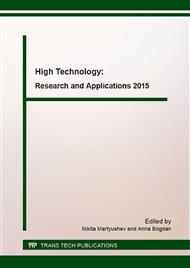[1]
Cutting Modes for Operations, Performed on Grinding and Finishing Manually and Semiautomatically Controlled Machines. Guide Book, ATOKSO printing house, Chelyabinsk, (2007).
Google Scholar
[2]
General Machine-Building Regulations on Cutting Modes for Technical Regulating of Operating Grinding Finishing Machines. NIItruda, Moscow, (1967).
Google Scholar
[3]
General Machine-Building Regulations on Cutting Modes for Technical Regulating of Operating Metal Cutting Machines. Part 3: Broaching, Grinding, and Finishing Machines, Printing House of the Central Office for Scientific and Technical Information, Moscow, (1978).
Google Scholar
[4]
General Machine-Building Regulations on Time and Cutting Modes for Regulating Works, Performed on Multipurpose and Universal Machines with Numerical Control. Part 2: Cutting Modes Rules, Economika Publ., Moscow, (1990).
Google Scholar
[5]
P. Krajnik, R. Drazumeric, J. Badger, F. Hashimoto, Cycle Optimization in Cam-lobe Grinding for High Productivity, J. CIRP Annals – Manufacturing Technology, 63 (2014) 333-336.
DOI: 10.1016/j.cirp.2014.03.036
Google Scholar
[6]
I. Gallego, Intelligent Centerless Grinding: Global Solution for Process Instabilities and Optimal Cycle Design, J. CIRP Annals - Manufacturing Technology, 56(1) (2007) 347-352.
DOI: 10.1016/j.cirp.2007.05.080
Google Scholar
[7]
P. Krajnik, R. Drazumeric, J. Badger, Optimization of peripheral non-round cylindrical grinding via an adaptable constant-temperature process, J. CIRP Annals - Manufacturing Technology, 62 (2013) 347-350.
DOI: 10.1016/j.cirp.2013.03.012
Google Scholar
[8]
D. Barrenetxea, J. Alvarez, J. Marquinez, I. Gallego, I.M. Perello, P. Krajnik, Stability analysis and optimization algorithms for the set-up of infeed centerless grinding, International Journal of Machine Tools & Manufacture, 84 (2014) 17-32.
DOI: 10.1016/j.ijmachtools.2014.04.005
Google Scholar
[9]
G.B. Lurie, Progressive Methods of Round External Grinding. Mashinostroenie Publ., Leningrad, (1984).
Google Scholar
[10]
P. Comley, I. Walton, T. Jin, D.J. Stephenson, A High Material Removal Rate Grinding Process for the Production of Automotive Crankshafts. J. CIRP Annals - Manufacturing Technology, 55(1) 2006 347-350.
DOI: 10.1016/s0007-8506(07)60432-6
Google Scholar
[11]
D.E. Anel'chik, Cycles of Defects-free Machining on Grinding Machines, Metal Cutting Machines; Republic Interdisciplinary Scientific and Technical Collected Book, 17 (1989) 68-71.
Google Scholar
[12]
J. Peters, R. Aerens, Optimization Procedure of Three Phase Grinding Cycles of a Series without Intermediate Dressing, J. Annals of the CIRP 29(1) (1980) 195-200.
DOI: 10.1016/s0007-8506(07)61321-3
Google Scholar
[13]
S. Malkin, Grinding Cycle Optimization, J. Annals of the CIRP 30(1) (1981) 223-226.
DOI: 10.1016/s0007-8506(07)60930-5
Google Scholar
[14]
B. Rowe, Principles of Modern Grinding Technology, William Andrew Publishing, Norwich, (2009).
Google Scholar
[15]
S.N. Korchak, Steel Details Grounding Process Effectiveness, Mashinostroenie Publ., Moscow, (1974).
Google Scholar


